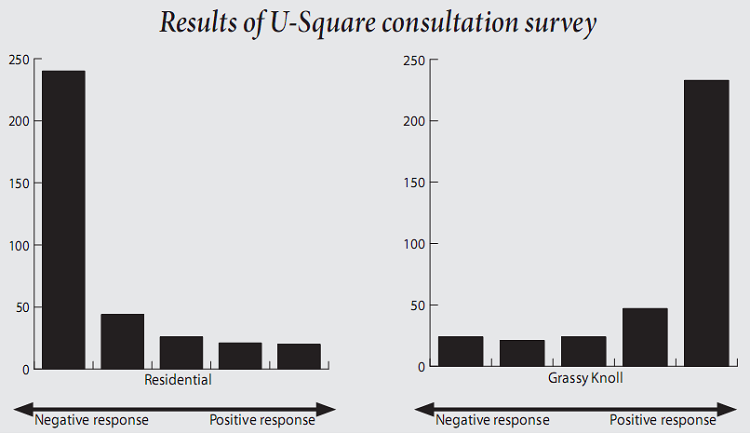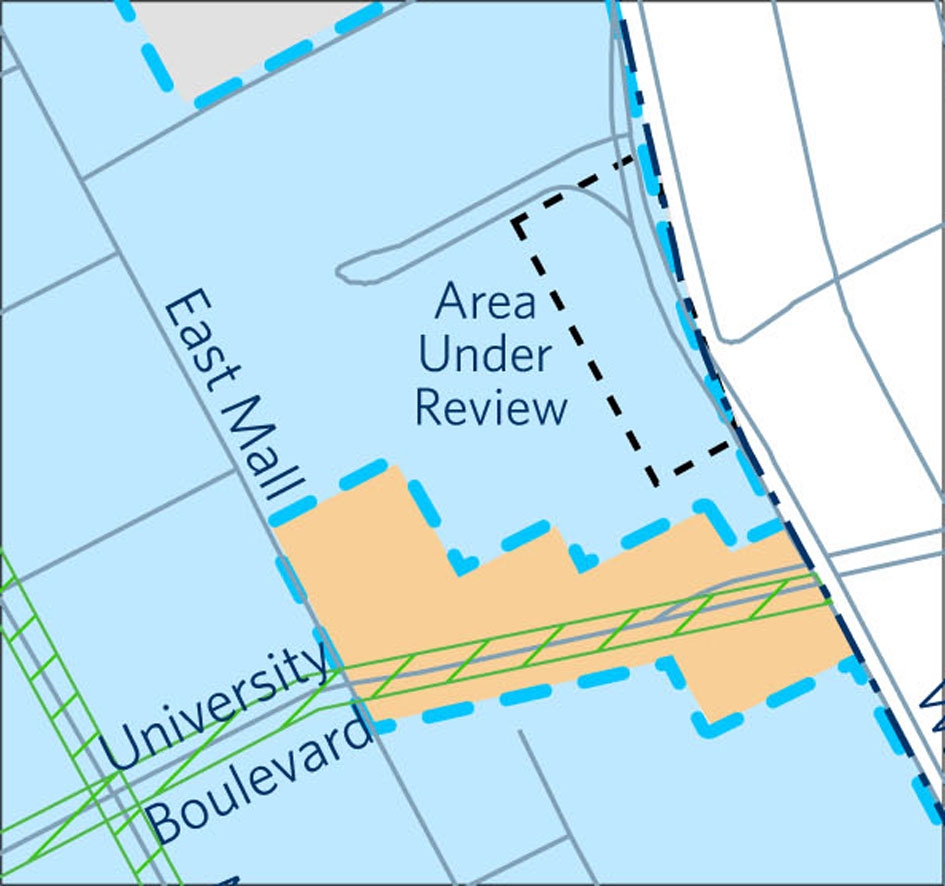The consultation period for the future of Gage South, the site of the current bus loop, is finally here. (It started last week but I was out of town at a conference and couldn’t do a write up.) Workshops are today from 1-4 pm and 6-9 pm. Details here.
Yesterday, a situation was described where the Board of Governors realized they had no long-term strategy for dealing with issues arising from land development. Rather than going through the four options and the lengthy questionnaire for Gage South in painstaking detail, I’d rather discuss how that lack of overarching plan is manifesting itself once again in Gage South.
All four options include non-student housing.
The fact that not a single vision for the area can be put forward that doesn’t include housing is an utter disgrace on Campus and Community Planning’s (C+CP) part. The message has been clear and unequivocal for years now: no non-student housing in the heart of campus. Here is a survey commissioned by the Board in 2007, about the University Square area, where the Knoll is.

UBC would probably classify this as "only moderate support for housing". (from the Ubyssey, Nov 13, 2007)
While this previous consultation, along with the successful NEW SUB referendum, was a major contributor to the nixing of market housing on the Knoll, it doesn’t appear that it was used beyond being a narrow input to the University Square area in particular. The message of a student-centric heart of campus and the prioritization of public space over housing should have been interpreted as the values of the community and used to inform the planning of other areas. It wasn’t, and the exact same themes are being played out over and over again as UBC moves from one area to the next.
While the “no housing” option is included on the consultation survey, it is included as a single option alongside multiple housing options. C+CP has already gone ahead to determine what housing might look like in various configurations, when all the feedback they’ve received up to this point is that it shouldn’t be there at all.
Nothing is funded.
It’s not mentioned in any of the materials, but every single project being pushed for this area does not have funding in place. Why in the world would UBC continue to push ahead with completely unfunded projects? This has been done constantly throughout the history of the U-Blvd area and it’s why the planning has been ongoing for a decade and why the centrepiece of the area, the NEW SUB, will be built with the majority of money coming from students.
UBC is still expecting Translink to chip in about $10M for the bus loop. Translink has not agreed to that and the whispers are that they won’t. They pulled their funding for UBC’s bus loop plans before, and the whole project (thankfully) collapsed. If Translink refuses to pay, that could easily prove to be a bigger decision-maker about what type of bus loop is constructed than any public feedback received. The placement and design of the bus loop would inevitably have a domino effect on the rest of the elements being built.
UBC’s feasibility study on the Aquatic Centre has pegged the cost of a new facility at $32M. Currently, a group of concerned alumni are mounting a campaign to save the current facility, arguing that the renovation plan considered by UBC was poorly conceived, resulting in inflated costs and an inferior design. A reminder: only one option was considered. This group of alumni have looked at other renovations options and will be proposing a more reasonable and cost-effective renovation plan to be considered. It’s based on concrete technical and architectural arguments and once again exposes the narrow focus of C+CP’s options.
What would the housing look like?
Nobody can say with certainty, because it’s constantly changing. In an attempt to make their housing plans for the heart of campus look more student-friendly, UBC has said that housing would also be made available to students. This was not in the original plan, and is something they don’t currently do. Existing “University Housing” is operated through a subsidiary of UBC called Village Gate Homes. Students are not currently eligible to rent any of Village Gate’s properties (I’ve tried, it’s cheaper than rez.)
Not only that, faculty/staff and student housing has been lumped into a supposedly inseparable combination. If you’re against faculty/staff housing in Gage South, you’re also against student housing. If you want student housing for the area, you also have to support faculty/staff being able to live there too. UBC’s existing and long-standing policy has been to have separate streams for student housing vs. faculty/staff housing. So how is it possible that they’re suddenly inseparable only in Gage South?
A policy of mixing all university groups in a single housing development may be a good idea. But that’s precisely the type of thing that should be looked at in the Board’s ongoing Housing Action Plan. A policy like this would have major long-term effects on what kind of university housing is built in the future. Instead, C+CP has instituted this policy on the fly as a short-term gambit to turn public opinion rather than as part of a long-term strategy. There are no details about it except the constant addition of “AND students” at the end of all housing descriptions, because it’s purely reactionary decision-making.
And at what price?
There’s been some confusion over the term “market housing” that needs to be cleared up. There are two definitions, depending on context.
- “Market” vs. “Non-market” in terms of who is allowed to live there. “Market” housing is open for the general public to live there. “Non-market” housing is restricted to a certain group, in this case UBC affiliates.
- “Market” vs. “Below market” in terms of rents charged. “Market” housing is priced according to the current rental market in the area. “Below market” is deliberately discounted to provide more affordable housing.
UBC’s been aggressive about using the term “non-market” housing to say that only UBC-affiliates would live there. However, they’ve avoided using the term “below market”. Instead, it’s been indicated that the rents will be at market prices. The term UBC is using for the housing is “affordable”, which has no official definition. It’s whatever they deem to be “affordable”. For reference, studio apartments at Thunderbird residence start at $834/month, for 404 sq. ft. It seems only logical that Gage South housing, which would be operated outside of UBC Student Housing, would be at least that price, if not more.
Of course, this could all change in an instant due to the erratic nature of UBC’s land use decision-making. The newest idea being pushed is social housing in partnership with BC Housing. Again, probably a good idea, but a PR move rather than one they were undertaking for its own sake.
Planning? What planning?
Gage South is a standard example (not an exceptional one) of how there’s no coherent plan in place for dealing with issues arising from UBC’s land use planning. Students have known this fact for years and are getting exhausted by it. It is encouraging that the Board of Governors finally seems to be catching on.
In the short term, this means rather than going through all of C+CP’s endless machinations, Gage South should be designated as “Academic” land so that it is a place the entire campus can take pride in, rather than only those who live overhead.








Discussion
Comments are disallowed for this post.
Comments are closed.